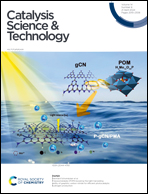High conversion of methane to methyl ester at 298 K†
Abstract
To establish an aerobic oxidation of methane to produce methanol with a high yield under ambient conditions is one of the dreams of researchers in academia and industry. However, although a lot of progress has been made on methane functionalization for several decades, it is still a great challenge to break through the selectivity-conversion limit in the aerobic oxidation of methane to methanol or methyl ester especially at room temperature. Herein, we report a simple visible-light driven reaction of CH4/O2 with CF3CO2H (HTFA) to CH3–O–COCF3 (MTFA) at 298 K, just using catalytic NaNO2 in an aqueous HCl/HTFA solution. In a batch reaction of CH4/O2 (1 : 5, 0.4 MPa), the yield of MTFA is over 90%. In a 7-day continuous experiment using CH4/O2 (2 : 1, 0.1 MPa), the MTFA selectivity and methane conversion are over 90% based on the methane input. The turnover frequency (TOF) is 2.5 molMTFA molNaNO2−1 h−1, and the turnover number (TON) is over 400. A reasonable reaction mechanism is suggested and partially confirmed by experiments, involving NOCl as a crucial species in the two-phase aerobic oxidation of methane to methyl ester. Methanol could be obtained with a commonly used hydrolysis of MTFA at 298 K. Neither metal catalysts nor special reagents are necessary in this two-step conversion of methane to methanol.



 Please wait while we load your content...
Please wait while we load your content...